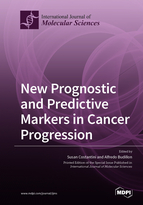New Prognostic and Predictive Markers in Cancer Progression
A special issue of International Journal of Molecular Sciences (ISSN 1422-0067). This special issue belongs to the section "Molecular Oncology".
Deadline for manuscript submissions: closed (30 September 2020) | Viewed by 66122
Special Issue Editors
Interests: cancer; cytokines; metabolome; NMR; systems biology; computational biology; molecular biology
Special Issues, Collections and Topics in MDPI journals
Interests: pharmacology; cancer; HDAC inhibitors; cell biology; proteomics; metabolomics; in vivo studies
Special Issues, Collections and Topics in MDPI journals
Special Issue Information
Dear Colleagues,
New molecular and “omics” technologies are leading to the identification of numerous biomarkers based on DNA, RNA, miRNA, and protein and metabolic alterations that may be combined with clinical pathological data to greatly improve the prediction of both cancer progression and therapeutic treatment responses.
Prognostic markers are used to evaluate a patient’s overall predicted outcome and cancer recurrence probability after initial interventions such as surgery or drug treatments, and hence, they can be used to select follow-up and further treatment strategies. On the other hand, predictive markers are specifically aimed at evaluating the probability of benefit from clinical intervention(s).
Thus far, few cancer biomarkers have entered into clinical practice. However, the search for new prognostic and predictive biomarkers is the object of many studies performed on cells, blood samples, and tissues. In this context, so-called “liquid biopsies” allow a snapshot of a patient’s pathophysiological state at a given time and provide dynamic monitoring with insight into the spatial and temporal clonal evolution processes of the tumor, including secondary resistance to treatment, which is prohibited by the invasiveness of tissue biopsies.
The aim of this Special Issue is to present the latest research on the identification of new genetic, epigenetic, protein, and metabolic cancer biomarkers. The potential to combine certain biomarkers through data integration by bioinformatics approaches such as machine learning as well as their roles as emerging novel drug targets will also be highlighted.
Dr. Susan Costantini
Dr. Alfredo Budillon
Guest Editors
Manuscript Submission Information
Manuscripts should be submitted online at www.mdpi.com by registering and logging in to this website. Once you are registered, click here to go to the submission form. Manuscripts can be submitted until the deadline. All submissions that pass pre-check are peer-reviewed. Accepted papers will be published continuously in the journal (as soon as accepted) and will be listed together on the special issue website. Research articles, review articles as well as short communications are invited. For planned papers, a title and short abstract (about 100 words) can be sent to the Editorial Office for announcement on this website.
Submitted manuscripts should not have been published previously, nor be under consideration for publication elsewhere (except conference proceedings papers). All manuscripts are thoroughly refereed through a single-blind peer-review process. A guide for authors and other relevant information for submission of manuscripts is available on the Instructions for Authors page. International Journal of Molecular Sciences is an international peer-reviewed open access semimonthly journal published by MDPI.
Please visit the Instructions for Authors page before submitting a manuscript. There is an Article Processing Charge (APC) for publication in this open access journal. For details about the APC please see here. Submitted papers should be well formatted and use good English. Authors may use MDPI's English editing service prior to publication or during author revisions.
Keywords
- cancer
- epigenetics
- circulating DNA
- proteins
- miRNAs
- metabolomics
- immune cells
- cell biology/tissue
- liquid biopsy
- systems biology








